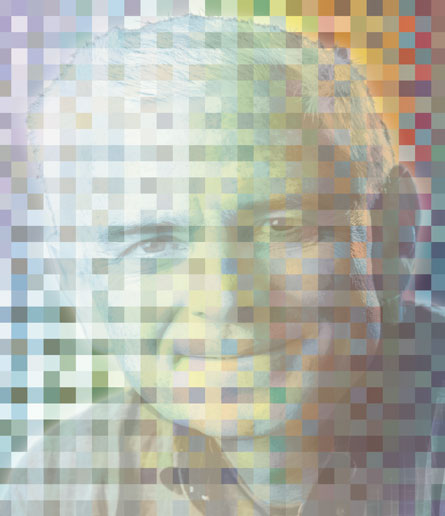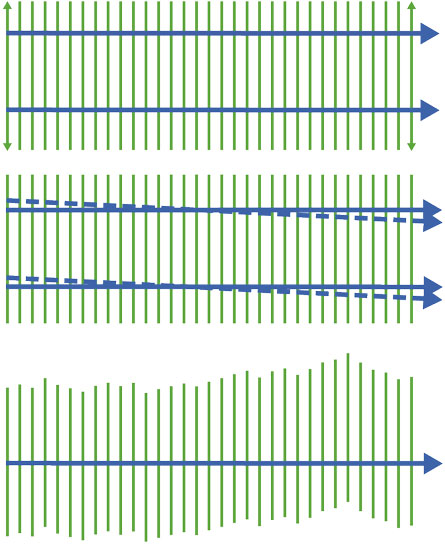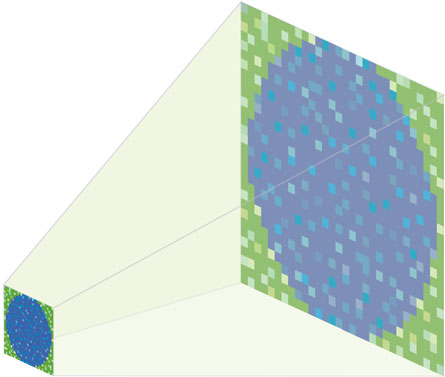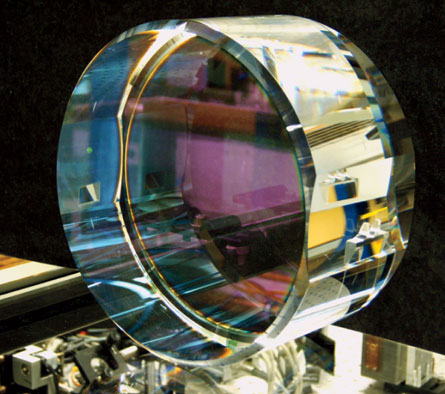Oh, the noise!
Oh, the noise! Noise! Noise! Noise!
That’s the one thing he hated!
The NOISE! NOISE! NOISE! NOISE!
— Dr. Seuss, How the Grinch Stole Christmas






The Grinch detested the noise created by the tiny residents of Whoville. Cosmologist Craig Hogan, in contrast, has become enamored of a noise he claims is generated by something even tinier — a minuscule graininess in the otherwise smooth structure of spacetime.
Call it Hogan’s noise. Many physicists are skeptical, but if his hunch about the existence of this subatomic clatter proves correct, it could have a mind-boggling implication: that the entire universe is nothing more than a giant hologram.
What’s more, it would mean that the structure of spacetime on subatomic scales might soon be revealed. “What’s new is that we can make a prediction and design an experiment to measure something on the tiniest of scales in the universe, and that’s what hasn’t been done before,” says Hogan, director of the Fermilab Center for Particle Astrophysics in Batavia, Ill., and a researcher at the University of Chicago.
In fact, it’s just possible that a detector in Hannover, Germany, built for an entirely different study, may have already recorded the noise generated by the smallest units of spacetime in the universe.
But Hogan’s model would go even deeper than that. It could lead to a major revision in how scientists think about spacetime, says theorist Bernard Schutz, director of the Max Planck Institute for Gravitational Physics in Potsdam, Germany. Hogan’s hypothesis suggests that information encoded on a tiny piece of spacetime could somehow influence the amount of information available to an observer from a region far, far away — violating a principle of physics known as locality. Rejecting locality would have major implications for attempts to knit together the quantum world — the subatomic realm — with Einstein’s general theory of relativity, which deals with gravity and the structure of spacetime on the very largest cosmic scales.
In most models that try to apply quantum theory to spacetime, the universe is indeed grainy, Schutz notes. But that graininess is usually the same everywhere in the cosmos. In contrast, Hogan’s model suggests the graininess isn’t uniform. It gets amplified the farther an observer resides from grains in a remote region of spacetime. That concept “would be a major revolution” in quantum gravity research, Schutz says.
Holographic pixels
Physicists often describe spacetime as “pixelated,” or carved up into tiny, indivisible units with a length of only about 10-35 meters — one ten-trillionth of a trillionth the diameter of a hydrogen atom. That’s much too small to be detected directly in any experiment. Or so most people have assumed.
Hogan combines the idea of pixelated spacetime with the notion, borrowed from string theory and quantum mechanics, that the universe is equivalent to a hologram. That notion holds that a surface enclosing a volume of space encodes all the information contained in that volume. Just as the hologram imprinted on a credit card reveals a third dimension, so too does an imaginary surface in spacetime appear to create an extra dimension.
The position of every particle in space is represented in quantum theory by a wave function, a mathematical formula for describing the probability that the particle has a particular location. In Hogan’s model, each grain of spacetime can be thought of as having a wave function associated with it, making spacetime fuzzy. (The fuzziness means that the position of a particle can only be known as precisely as the length of each grain.)
Each grain is much too small to measure. But as a wave travels through space, it interferes with waves from adjacent grains (adjacent patches of spacetime), producing an interference pattern — a band of light and dark fringes — that on a distant screen is large enough to be measured.
In Hogan’s model, the larger the hologram, the larger the interference pattern. If the hologram is big enough, the traveling waves produce a kind of macro-scopic jitter, or noise, which could be recorded with a relatively inexpensive experiment, Hogan asserts.
He and his colleague Mark Jackson, now at Leiden University in the Netherlands, described their ideas last year in Physical Review D. Hogan has also posted his latest work online on arXiv.org.
If Hogan is right, he has made a breakthrough in understanding the quantum world. Despite decades of effort, physicists have not yet successfully melded quantum theory with gravity, an essential step in forming a complete theory of the universe. Since the 1950s, scientists have managed to develop complete quantum versions of the other three known forces in nature — the electromagnetic force; the strong force, which binds protons and neutrons together; and the weak interaction, which is responsible for certain kinds of radioactive decay. Gravity is the last holdout.
Most attempts to quantize gravity assume the existence of quantum fields that obey the concept of locality, which holds that an event in one region can affect only what happens in an adjacent region. A change in an electric field in one region of space, for instance, affects only fields in an adjacent region. But Hogan’s model suggests that theorists should seriously consider a quantum theory of gravity in which two very different regions of spacetime, despite their vast separation, can still profoundly influence each other, Schutz notes.
But like many physicists, Schutz says he is skeptical about the details of Hogan’s model, which appears to be mainly conceptual. Hogan, for his part, readily admits his model is not fundamental — it doesn’t explain why there is a fundamental unit of length, for instance — but it predicts a specific type of noise that could be verified by experiments.
“One thing that Hogan emphasizes in his papers is that he is providing phenomenology rather than underlying theory” about holography, spacetime and information, says theorist Christopher Herzog of Princeton University.
Black illusions
Gravity was first theoretically linked to information in the 1970s, when Stephen Hawking of the University of Cambridge in England and Jacob Bekenstein, now at the Hebrew University of Jerusalem, realized that there was a deep relationship between thermodynamics, which is the study of heat transport, and black holes. According to the second law of thermodynamics, the entropy of a system — a measure related to the amount of information it holds — cannot decrease over time. Hawking showed that for that to be true, a black hole must increase its entropy by an amount greater than the entropy carried by a body that falls into the hole.
Bekenstein calculated that the entropy of a black hole is entirely determined by its effective surface area, or event horizon, not its volume. The event horizon is the imaginary surface that surrounds a black hole and marks the point of no return: Any entity — be it a planet or a string quartet — that gets closer to the hole than the event horizon is doomed to fall in.
In the 1990s, two scientists dramatically extended this idea into a “holographic principle” that states that a volume of space can be entirely described by what happens on its boundary. Nobel laureate Gerard ’t Hooft of the University of Utrecht in the Netherlands first proposed the idea. Stanford physicist Leonard Susskind then gave the idea a more precise description according to the precepts of string theory, which holds that each elementary particle can be represented by tiny, vibrating snippets of string in nine or 10 dimensions of space, rather than the usual three.
Applying the holographic principle to the real world has proven challenging. It can be difficult to relate a theory about a volume of space with, say, five dimensions, to a simpler theory that envisions a universe that is restricted to the boundary, or surface, of that volume — a universe with one less dimension. But in 1997, Juan Maldacena, now at the Institute for Advanced Study in Princeton, N.J., used string theory to show that in one model, there truly is a one-to-one correspondence between the description of a volume of space in a higher dimensional theory that includes gravity and a lower dimensional theory — the boundary of that space — in which gravity plays no role.
Consider, once again, Hogan’s proposed holographic surface. It’s made of tiles that each have a length, about 10-35 meters, equal to a fundamental unit known as the Planck length, named for Max Planck, the father of quantum theory. The information encoded on the surface corresponds to the number of Planck tiles covering that surface.
According to the holographic principle, the information on the surface must be exactly the same as that contained within the volume. But that can be true only if the volume is much grainier, or blurrier, than the Planck-length tiles on the surface. In other words, the tiles that fill the volume are much bigger than those on the surface. Effectively, the blurriness of the information encoded on the surface becomes magnified within the volume enclosed by the hologram.
Hogan calls this magnification “the holographic uncertainty principle.” He sees it as an extension of the uncertainty principle proposed by German physicist Werner Heisenberg in 1927. Heisenberg famously noted that the position and momentum of a subatomic particle cannot both be precisely measured at the same time.
“I think Hogan must see himself as a sort of latter-day Heisenberg,” says Herzog. “Just as Heisenberg provided us with an uncertainty principle without a full-fledged theory of quantum mechanics, Hogan is hoping that his holographic uncertainty principle will be a similarly important result in a full theory of quantum gravity.”
This larger size of the tiles within the volume becomes noticeable only at very large distances from the holographic surface, Hogan notes. A sensitive device that could measure changes in length in two perpendicular directions at large distances from the surface might therefore be sensitive to this fundamental limit of encoding information, he says.
That ought to put a smile on the face of scientists trying to uncover and comprehend the smallest units of spacetime. But not everyone is convinced.
Theorist Maldacena notes that “theories of quantum mechanical spacetime, such as string theory, are constructed so that they respect the symmetries of spacetime, such as the symmetries of special relativity.” In contrast, he says, Hogan’s proposal violates one of the foundations of special relativity, namely that lengths (and time) are not absolute quantities but contract or expand in such a way that the speed of light always has the same numerical value, regardless of the speed of an observer.
Hogan agrees that his theory of holographic noise does indeed violate special relativity. But he adds that relativity theory does not take into account the quantum nature of spacetime. Some as-yet-unknown symmetry of quantum gravity is likely to supersede some of the concepts of special relativity, which might break down on the tiniest of subatomic scales, he asserts.
Because of this violation, Hogan’s model is not consistent with the holographic ideas in string theory, Maldacena insists. “So it would be more accurate to call his noise ‘Hogan’s noise,’” he says.
Regardless of what it’s called, this new kind of noise brings together elements of several previous ideas, as Hogan acknowledges. In 1999, Giovanni Amelino-Camelia, now at the University of Rome La Sapienza, published a study suggesting that quantum-gravity noise might show up in large-scale experiments.
Noisy experiments
Indeed, Hogan is hoping that two experiments — one ongoing, the other in the planning stages — may find evidence for the quantum clatter.
Since 2002, a British-German apparatus called GEO600 has been searching for the notes of a cosmic symphony — ripples in spacetime known as gravitational waves — that general relativity says ought to exist. Such waves should be generated any time a dense body, such as a neutron star or black hole, is accelerated.
The experiment, based in Hannover, Germany, hasn’t found any of these waves. But part of the signal that GEO600 has detected might be accounted for by holographic noise, Hogan says.
GEO600, like some other gravitational wave detectors, uses laser light to measure tiny changes in the relative lengths of two perpendicular arms of an interferometer. A gravitational wave would alternately expand one arm ever so slightly while compressing the other. GEO600 uses a single laser beam, split into two beams by a half-silvered mirror, to measure and compare the two lengths.
Because of the experiment’s design, GE0600 is much more sensitive to the sideways motion of the beam splitter than are other large gravitational wave detectors. And an unexplained sideways motion of the beam splitter is just “the effect claimed by Hogan as a consequence of his holographic noise,” says GEO600 principal investigator Karsten Danzmann of the Leibniz Universität Hannover.
In fact, about a year ago, Danzmann and his colleagues thought an unexplained noise that GEO600 had recorded could be Hogan’s noise. However, most of the instrumental noise recorded at relatively low frequencies — from a few hundred hertz to over 1,000 hertz — has now been accounted for by known sources within the detector, says Danzmann. “But the uncertainty in our noise is still large enough to accommodate a signal as predicted by Craig Hogan,” he adds.
Hogan’s noise is predicted to have the same strength at all frequencies, and Danzmann’s team is now analyzing motion of the beam splitter recorded at higher frequencies. Within a year, the team should know whether its findings support Hogan’s prediction.
“Hogan gets to the point of ‘predicting’ … the actual magnitude of the ‘noise anomaly’ seen at GEO600,” says Amelino-Camelia. “The reason why I essentially stopped working on my quantum-gravity noise proposal was that indeed I couldn’t find any way to really get a robust intuition for the magnitude one should or could expect for this noise.”
But even if GEO600 finds a jitter that resembles the noise that Hogan predicts, it will take a much more sensitive experiment to prove the fuzzy, holographic nature of spacetime, says Schutz.
Such an experiment is now in the planning stages at Fermilab, Hogan says. The proposed $2-million apparatus would feature a pair of interferometers, each with perpendicular arms 40 meters in length. Initially, the two experiments would be placed next to each other, testing a key prediction of Hogan’s theory: The noise recorded by two adjacent devices ought to be correlated.
“They move together because the whole of spacetime they are sitting in is jittering around,” says Hogan. If one device records a type of motion that might be attributed to quantum jitter but the other device does not, Hogan’s theory would be ruled out.
But if the noise is detected, the next test would be to move the two interferometers farther apart. At large separation, the correlation between the amount of noise in the two detectors should shrink to zero according to Hogan’s model, says Stephan Meyer of the University of Chicago.
If it all works, the experiment could give a first glimpse of the tiniest scraps of spacetime. But whether Hogan’s noise will be revealed, only time — make that spacetime — will tell.







